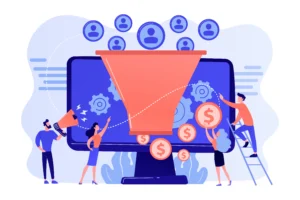
Prerak Mehta
February 14, 2024
In today's digital age, having a conversion-focused website design is crucial for maximizing online success. By implementing strategic elements and techniques, you can captivate visitors, enhance user experience, build trust, and ultimately drive conversions. Let's explore some key takeaways from each section of this article.
Craft a compelling value proposition that clearly communicates the benefits of your products or services.
Design engaging call-to-action buttons that prompt visitors to take desired actions.
Ensure your website is optimized for mobile responsiveness to cater to users on various devices.
Simplify menu structures and provide clear pathways to help users navigate your website seamlessly.
Utilize interactive elements to engage visitors and make the user experience more dynamic.

I’ve learned that nailing your value proposition is like hitting the bullseye in a game of darts. It’s the sweet spot that grabs attention and tells visitors why they should stick around. Your value proposition should be a clear declaration of the benefits your product or service offers. It’s not just about being different; it’s about being better in a way that matters to your customer.
Identify the main problem you solve.
Pinpoint your unique benefits.
Communicate the outcome your customers can expect.
Remember, it's not about what you do; it's about what your customers get out of it. This mindset shift can make all the difference in how you articulate your value.
It’s crucial to keep it simple but powerful. You don’t need fancy jargon to make an impact. Just tell me straight up—how will my life be better with what you’re offering? That’s the kind of message that resonates and converts.
Let’s talk about the heart of your homepage: the call-to-action (CTA). This isn’t just a button; it’s your virtual salesperson, your online handshake, your ‘Hey, don’t leave just yet!’ moment. Your CTA should be impossible to ignore. It’s not just about the color or the size, but the message it carries. You want to make your visitors feel like they’re missing out if they don’t click.
Here’s a quick list of what makes a CTA work wonders:
Clarity is king. Be clear about what you’re offering.
Make it pop. Contrasting colors can make your button stand out.
Keep it simple. A busy button is a bypassed button.
Urgency sells. Phrases like ‘Limited time offer’ can work magic.
Remember, a great CTA is about making that connection. It's about creating a sense of urgency and relevance. Your visitors should feel compelled to act, and act now.
And hey, if you’re looking for some inspiration, check out ‘17 Best Practices for Crazy-Effective Call-To-Action Buttons‘. It’s a treasure trove of tips to get that higher CTR and more conversions. Because at the end of the day, it’s those beautiful buttons that can make or break your online success.
Let’s face it, we’re glued to our phones. So, when I’m designing a website, I make sure it’s as thumb-friendly as possible. Mobile responsiveness is no longer optional; it’s a must to keep visitors engaged. I focus on making navigation a breeze, with menus and buttons that are easy to tap, and content that’s a joy to read on a small screen.
Responsive images and videos are key. They need to adapt seamlessly to different devices, ensuring a quality experience no matter the screen size.
Fonts and touch elements should be sized appropriately. Nobody likes to squint or miss a button because it’s too tiny!
Speed is crucial. I optimize for quick loading times because if a page takes too long, users will bounce faster than a rubber ball.
Remember, a mobile-friendly website is about giving users what they need quickly and without hassle. It's about creating an experience that feels natural on their device.

I’ve always believed that a clean, straightforward menu is the backbone of a user-friendly website. Keep it simple, and your visitors won’t get lost in a maze of links. Here’s what I focus on:
Prioritizing essential pages to ensure they’re front and center.
Grouping related items together to make browsing intuitive.
Limiting the number of menu items to avoid overwhelming users.
Remember, every extra menu item is a new decision your visitor has to make. By reducing choices, you’re not only decluttering the space but also streamlining the path to conversion. It’s like I’m guiding them through a clear, open road rather than a crowded city street.
The goal is to create a navigation menu that feels like a helpful guide, not a hurdle.
And don’t just take my word for it. Through A/B testing, you can transform your navigation menu into a seamless and conversion-focused experience for your website visitors. It’s all about finding that sweet spot where simplicity meets functionality.
When I’m designing a site, I always focus on making sure visitors can find their way around effortlessly. Clear pathways are not just about a neat menu; it’s about guiding users through their journey on your site. Think of it as creating a map that leads to treasure – your products or services.
Here’s a little secret: I love using breadcrumbs. No, not the kind you find in the kitchen, but the ones that show you where you are on a website. They’re like a trail of digital bread crumbs leading you back home. Check out my quick guide below:
Title: Guide to Implementing Breadcrumbs (with Step-by-Step Instructions)
Snippet: Breadcrumbs in web design are crucial for enhancing user experience by providing a clear path back to the starting point of navigation.
Remember, the goal is to make navigating your site as intuitive as playing your favorite video game. You want users to move through your content with ease, finding exactly what they need without any frustration.
And don’t forget, every page should have a purpose and lead somewhere. If a page feels like a dead end, it’s time to rethink its role in the user’s journey. Keep it simple, keep it clear, and watch your visitors turn into customers.
I’ve always believed that a website should be more than just a pretty face. It’s about creating a space where visitors can engage, not just gaze. Interactive elements are the game-changers here. They turn passive viewers into active participants, and that’s a big deal for keeping people interested.
Here’s the thing: interactive features can range from simple hover effects to complex games or quizzes. But no matter the complexity, they all serve to enhance the user experience. For instance:
Hover effects can highlight important features
Sliders can showcase products in a fun way
Quizzes can offer personalized recommendations
Remember, the goal is to make your visitors feel involved. When they interact with your site, they're forming a connection. That's invaluable.
And it’s not just about fun and games. Interactive elements can also provide valuable feedback. They let you see what interests your visitors, which can be a goldmine for improving your site and tailoring your services. So, I always make sure to incorporate some level of interactivity in my designs. It’s a win-win for everyone.

I’ve learned that nothing builds trust quite like the honest words of satisfied customers. Real testimonials are like gold dust on my site; they’re proof that I’m not just tooting my own horn. I make it a point to collect and display these gems prominently, because let’s face it, we all want to know that others have sailed these waters before us and had a great voyage.
Here’s the thing: I don’t just slap up any old comment. I’m selective, choosing reviews that tell a story or highlight a benefit. It’s not just about five stars; it’s about the experience. And I’ve got a knack for picking out the ones that resonate.
I make sure every testimonial is a mini-story, one that potential customers can see themselves in. It's not just praise; it's a narrative that connects.
I also keep an eye on platforms that help me gather and showcase these reviews. One such platform is Feefo, which is great for boosting credibility. Its platform emphasizes authenticity by ensuring that all reviews are from verified customers. Plus, it provides insightful analytics that help me understand what’s working and what’s not.
I’ve always believed that a nod from a well-known figure can work wonders for your brand. It’s like getting a thumbs-up from the cool kids in school; suddenly, everyone wants to sit at your table. Influential endorsements can significantly amplify your credibility and, by extension, your conversion rates.
Partner with industry leaders
Collaborate with celebrities or influencers
Feature expert approvals
Remember, it's not just about getting a big name to back your product; it's about finding someone whose values align with your brand. That's when the magic happens.
When I started incorporating endorsements into my website, I made sure they were visible but not overwhelming. It’s a delicate balance, but when you get it right, it’s incredibly effective. Keep it authentic, and let those endorsements speak for themselves.
I’ve found that user-generated content (UGC) is like gold dust for boosting engagement and trust on my site. It’s all about getting my audience involved and showing off how real people use and enjoy my products. Here’s how I make the most of it:
Create a hashtag contest: I encourage my followers to post their own photos or videos using my products with a specific hashtag. It’s a win-win; they get to be featured, and I get a bunch of authentic content.
Feature customer stories: I love sharing how my products have made a difference in someone’s life. It’s not just about the product, it’s about the experience.
Encourage reviews and ratings: I always ask for feedback. Positive reviews are displayed prominently, and I don’t shy away from the negative ones either. They show I’m human and committed to improvement.
Remember, it's not just about collecting content; it's about curating it. I make sure to showcase the pieces that align with my brand's voice and values.
By integrating UGC, I’ve seen a noticeable uptick in engagement and conversion rates. It’s a testament to the power of community and shared experiences.

I’ve learned that the art of crafting persuasive product descriptions is a game-changer in e-commerce. It’s not just about listing features; it’s about painting a picture that places your product center stage in your customer’s life. Think of it as storytelling where every word counts.
Highlight the benefits, not just the features
Use sensory words to evoke emotions
Keep it concise but informative
A good description will demonstrate the item’s unique selling point, which helps to attract new customers. Usually, these descriptions are brief and concise, ensuring that the customer can quickly grasp the value of the product. Remember, you’re not just selling a product; you’re offering a solution to a problem or an enhancement to their lifestyle.
Keep your language simple and accessible. Jargon can confuse potential buyers, turning them away before they've even considered the purchase.
I’ve learned that the headline is the make-or-break moment for your content. It’s the first thing people see, and it’s what decides whether they click or scroll past. So, I put a lot of thought into crafting headlines that grab attention. Your headline should promise something valuable. Will your readers learn something new? Will they get a laugh, or find a solution to a problem? Make that promise clear.
Here’s a quick list of headline hacks I swear by:
Use numbers to give a sense of structure, like “7 Ways to…”
Ask a question to provoke curiosity
Use powerful adjectives for emotional impact
Keep it short and sweet for easy scanning
Remember, your headline sets the tone for the entire piece. It's not just about being catchy; it's about being clear and setting the right expectations. If you can nail that, you're halfway to winning your reader's click.
I’ve come to realize that tapping into emotions can be a game-changer for my website. Emotional triggers are key to making a connection with my visitors, nudging them towards taking action. It’s not just about the logic of the offer; it’s about how it makes them feel.
Joy can create a sense of excitement and anticipation.
Trust fosters a feeling of safety and reliability.
Fear of missing out can urge quick decision-making.
Surprise can break the monotony and grab attention.
Remember, the goal is to evoke an emotional response that aligns with your brand's message and compels the visitor to act.
I’ve learned that personalization is a powerful tool in this regard. When I tailor my content to resonate with my audience’s desires and fears, the impact is profound. It’s about showing empathy and understanding their journey, which in turn, boosts my conversion premium.
And there you have it! By implementing the tips and strategies discussed in this article, you are well on your way to mastering conversion-focused website design and increasing your online success. Remember, the key is to continuously test, analyze, and optimize your website to ensure it is always performing at its best. So go ahead, put these tips into action, and watch your online success soar! Good luck!
Crafting Digital Excellence at NetMafia. Elevate your online presence with our passion for precision and relentless pursuit of web mastery. Join us in building your digital legacy today.
© Copyright NetMafia. All right reserved.